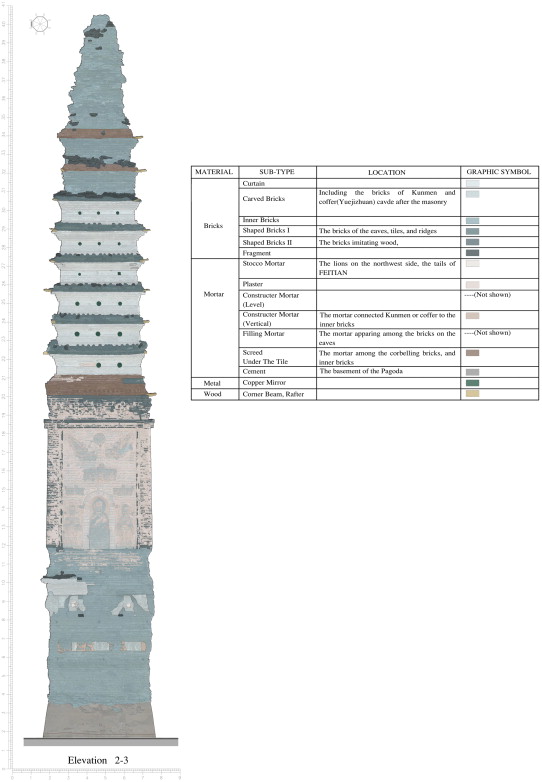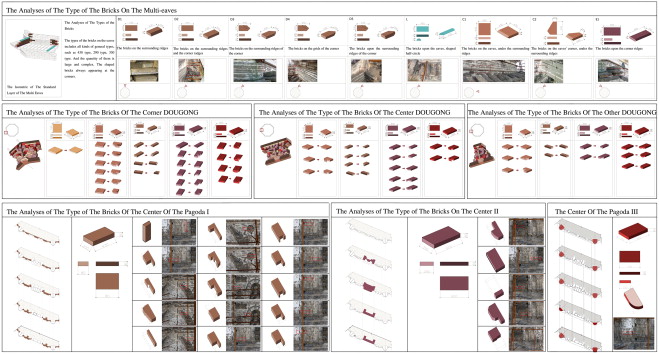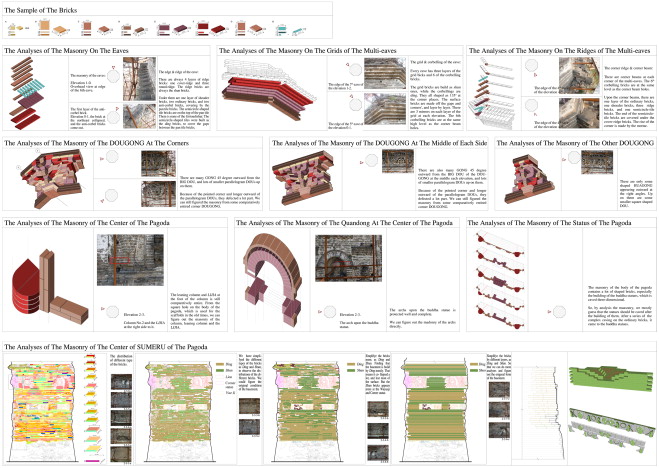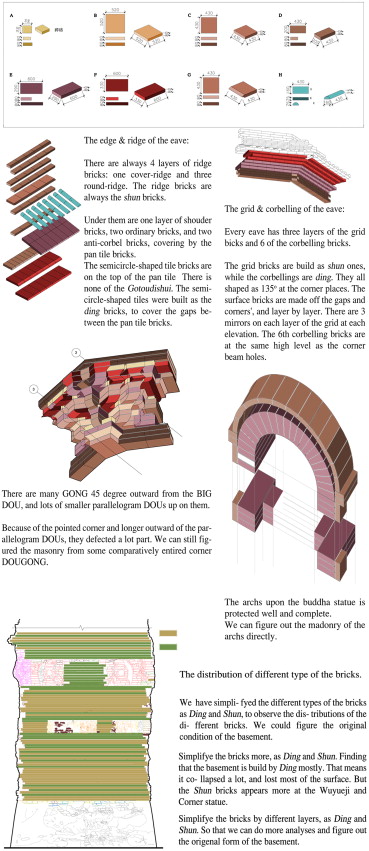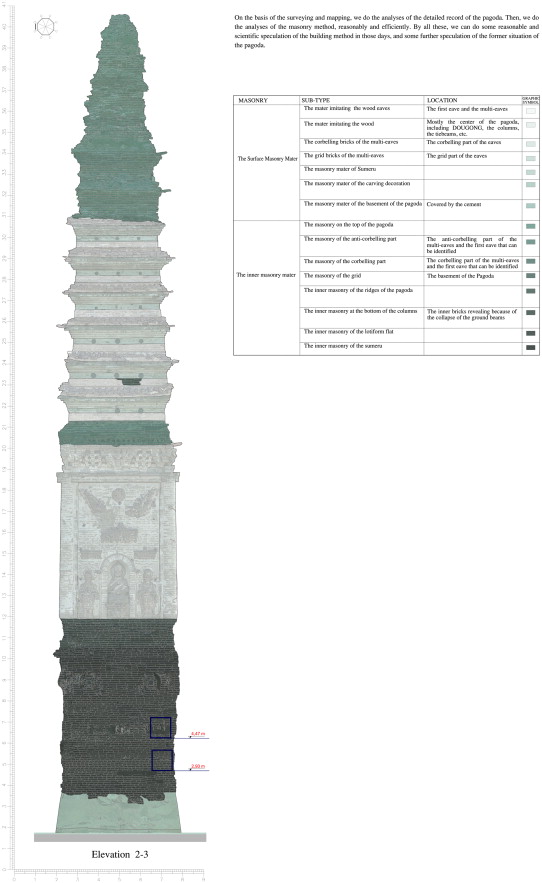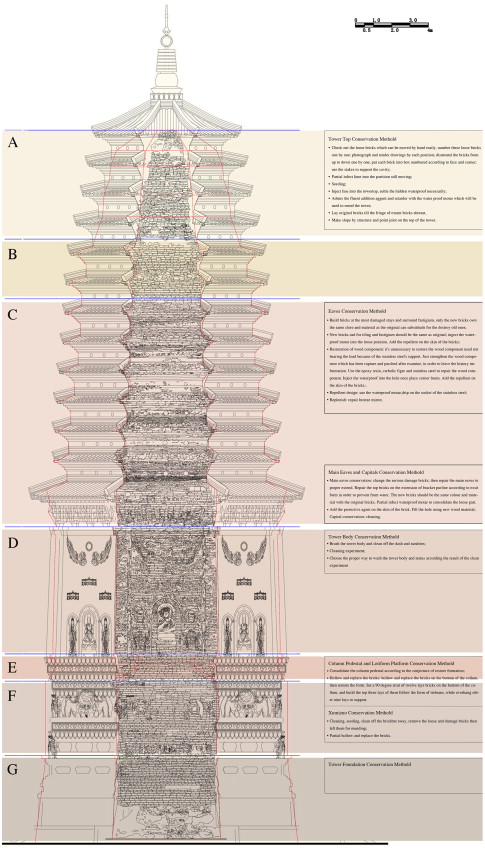Abstract
The current paper discusses the conservation and restoration of the Guang Sheng Si Pagoda of the Liao Dynasty in Liaoning Province, China. The Southeast University, together with the Conservation Center of Liaoning Province, the Sapienza University of Rome, and the IUAV University of Venice, organized a workshop on the current project, which consists of a preliminary investigation, the restoration design, and on-site construction. The current study attempts to introduce the expressing procedure through precise on-site investigations and the rendering of restoration drawings based on the integral definition of the structural damages. This project is a new technique in the field of traditional restoration in China.
Keywords
Pagoda of the Liao Dynasty ; Conservation ; Survey ; Masonry
1. Introduction
The brick-stone multi-eave pagoda of the Liao Dynasty follows the characters of the Khitan culture and is derived from the same pagoda type of the Tang dynasty. Most of its remains, which are located in Beijing, Hebei, and Liaoning as well as Inner Mongolia, are massive brick structures that can be regarded as both sculpture and architecture. To date, more than 70 Liao brickstone multi-eave pagodas survive.
The Guang Sheng Si Pagoda of the Liao Dynasty in Liaoning Province was established around the 12 A.D. It is made of an octagonal brick structure, and the corner beams and rafters of the first eave are made of wood. The pagoda is huge, with a diameter of up to 15 m and a remaining height of approximately 40 m. Most of the structure is well preserved. Several facing bricks, a Dougong, and carvings at the central part of the body and the multi-eaves were saved, but the bottom-facing bricks are mostly damaged. The lotiform flat had collapsed and the pagoda body is weathered. The upper part of the multi-eaves as well as that of the pagoda is gone. The inner structure of the first eave is exposed because of the collapsed first eave and lotiform flat. A number of long cracks between the detached column and the pagoda body can be seen on the structure through the space left by the first eave and the bottom of the column; this problem should be immediately resolved because it is a security problem for the main structure.
In line with the restoration of this pagoda, the Southeast University organized a workshop that aims to enhance the communication between the Eastern and Western countries focusing on the restoration of bricks and monumental stone architectures. In cooperation with the Sapienza University of Rome and the IUAV University of Venice, the current project proposes a repair plan and gives suggestions and recommendations for the restoration program. We hope that the experience of our Western counterparts in the field of historical architectural restoration theory as well as their technological expertise can help in the domestic efforts and actual projects on the area of architectural heritage protection.1
The restoration of the Guang Sheng Si Pagoda consists of three stages, namely, a preliminary investigation and survey, the working drawing design, and construction. The first stage includes surveying and mapping, historical studies, typological research, decoration research, material analyses, masonry method analyses, and a mutilation situation study. Surveying and mapping relied on the experience of our counterparts from the Sapienza University, who used the electronic total station and the photo measuring methods to record in detail the condition of the remaining material, as well as the shape, property, and surface conditions. Some laboratory methods were also used in some analyses. The material analyses include chemical analyses and slice observations. These methods provided additional scientific information for the study. The deterioration situation study, which is concerned with the structure as well as the material surface, is an important attempt based on the Italian material surfacing mutilation study system.
Using the scientific surveying and mapping method, extensive on-spot information was collected and pigeonholed to ensure the accuracy of the surveying and mapping results. Some research and analyses were then conducted in accordance with the objective of the survey to immediately form a scientific method of protection and restoration. Compared with the existing domestic restoration methods, the current program focuses more on the accuracy of the details and on the scientific record of existing historical information to ensure that the restoration method is pertinent. Based on the assumptions from both the present situation and the existing information and using the proper operation method recommended by the Sapienza University of Rome and the IUAV University of Venice, we propose the corresponding methods for the restoration of this pagoda, which may prove meaningful in future field studies.
2. Working method
The established plan includes documentation, research, and decision-making, which depends on the integrity and accuracy of the documentation, including basic data collection, on-site geometry mapping, and track investigation recording. The research includes the historical analysis, as well as material and damage analyses and bricklaying (Fig. 1 ).
|
|
|
Fig. 1. Speculation on the previous condition of the Guang Sheng Si Pagoda. |
2.1. Survey and mapping
We recorded the external form of the pagoda, especially the Rules Characters and the collapsing situation, using photo measuring as well as accurate measuring instruments such as the rangefinder and the electronic total station. We then portrayed an accurate and detailed map of each elevation based on the on-site survey.
2.2. Analyses
Analyses on the detailed records of the pagoda were conducted, and the collapsed parts and the reasons for the collapse were identified. The details of the material and the main brick styles, as well as the masonry method, were also systematically analyzed. Furthermore, we speculated on the principle behind the building method during that period as well as the former situation of the pagoda. By considering both the collapsing situation and the speculations, we developed a more scientific and feasible design for the protection and restoration of the pagoda.
2.3. Historical research
The locations, forms, and cultural status of the more than 70 surviving pagodas from the Liao Dynasty were obtained from statistical information. The results were then used to determine the position and historical status of the Guang Sheng Si Pagoda.
After collecting the documents on the existing Liao pagoda, its status became apparent. Its height is among the top 10 highest pagodas in China, except for the 70.04 m high Bai pagoda in Liao Yang. Interestingly the heights of almost all pagodas are approximately the same at 40 m. The Liao pagoda shows maturity with its integral construction proportion and masonry style based on its late architectural age, which reflects its distribution characteristics, specifically in the major area of the Liao Pagoda construction region. Thus, the following rules can be concluded:
Rule 1 : the Liao dynasty has more pagodas at the edge of the territory of the Jin and Liao dynasty, most of which are located at the eastern coastal regions and developed in the relevant.
Rule 2 : the towers in several large cities of the Liao Dynasty are existing examples of. For example, the number of pagodas during the Liao dynasty progressively decreased around the five capitals of the Liao dynasty, with the distribution depending on the influence of each city.
Research on the original pagoda is another important part of the historical research. Although restoration is not the primary purpose, it is the key to the decision-making and restoration methods to adequately determine the original appearance of the damaged parts. The original research on the Guang Sheng Si Pagoda focused on the serious damage on the multi-eave tower, especially on the ninth floor, which was caused by the lack of bricks on the surface. Thus, the height of each level and the positions and levels of the eaves should be accurately investigated on site. Using the track investigation, the shaped bricks, and the research on the bricklaying style, the original feature beyond the ninth floor can be inferred. The sizes of the corbel eaves on all floors are the same, and the size of the corbel and roof bricks is similar to those of the floors beneath. The changes in the pagoda figure can be adjusted using the size changes in the pagoda body. Research on the original appearance concentrated on the base of the Xu Mi Zuo below the pagoda body. Considering the disappearance of the lotus throne, which leaves the stone lion in the Kunmen the only erect one, the cantilevered size and height and the layers of the lotus should be based on the existing construction and height of the inner bricks, using the surrounding situations for reference.
3. Operating instructions of the field sketch
During the planning of the traditional Chinese restoration, the surveying procedure aimed to examine the original features and interpret the conditions of the tracks and damages through the use of a sketch map, detailed maps, and text descriptions. Moreover, the current project provides a precise analysis of the damages on the surfaces to comply with the on-site control surveying. The exact processes are discussed in the subsequent sections.
3.1. Control surveying and total station observation
The basic function of the total station is to measure the horizontal and vertical levels of the corners. The objective point, such as the horizontal coordinate data and so on, can be collected using the software integrated in the machines. The surveying and mapping data are then transferred into the CAD software to generate a three-dimensional (3D) control point. In the survey of the Guang Sheng Si Pagoda, eight observation stations (CH0-1, CH1-2, CH2-3, CH3-4, CH4-5, CH5-6, CH6-7, and CH7-0), eight switching stations (A, B, C, D, E, F, G, and H), and 15 wires (DX01–DX15) were established. The switching stations had to be in contact with one another because the wires cannot be established between each observation station. The entire control net can be led and located (Fig. 2 ).
|
|
|
Fig. 2. Control surveying. |
3.2. Detail surveying using a 3D scanner
A large amount of data called “point clouds” was obtained by scanning the pagoda using a 3D scanner. These “point clouds” consist of 3D coordinates that match all data to form a 3D figure. The “point clouds” should be coordinately used with the control net obtained from the total station because of the relatively low accuracy of the “point clouds” from the 3D scanner (Fig. 3 ).
|
|
|
Fig. 3. Surveying and mapping facade. |
3.3. Present response—photographic survey using a digital camera
The overall purpose of the current survey is to determine the history of the architecture itself, especially its status in terms of damage. We can directly observe the damage situation at different positions by overlapping both the digital fusion pictures and the “point clouds” (Fig. 4 ). The normal method involves the use of a lift and then obtaining the projection photos of the façade. However, the lift cannot be used because of the height of the pagoda and the limited space. Thus, picture stitching at a range of 3 m×2 m was adopted, and 120 photos were taken on each side.
|
|
|
Fig. 4. Photographic survey by digital camera. |
3.4. Photo stitching instruction
Photo retouching is crucial in surveying and is the basic point in the subsequent analysis of damage and repair design. The photos must be simultaneously controlled using the brick location, 3D scanner, and total station to ensure a high accuracy (Fig. 3 ). Without any efficient software, photo stitching was manually done using the brick floors and control points of the total station.
4. Description of the drawings
The bricklaying and damage analyses were helpful in determining the current situation, and the exact analysis of the brick surface was then concluded (Fig. 5 , Fig. 6 , Fig. 7 , Fig. 8 , Fig. 9 , Fig. 10 , Fig. 11 , Fig. 12 ; Fig. 13 ).
|
|
|
Fig. 5. Detailed photographic survey using a digital camera. |
|
|
|
Fig. 6. Analyses of the masonry method. |
|
|
|
Fig. 7. Analyses of the mortar. |
|
|
|
Fig. 8. Analyses of the type of the bricks. |
|
|
|
Fig. 9. Analyses of the masonry on different parts of the pagoda. |
|
|
|
Fig. 10. Analyses of the masonry on different parts of the pagoda. |
|
|
|
Fig. 11. Analyses of the inner and outer masonry style. |
|
|
|
Fig. 12. Analyses of slicing observation (1 m×1 m). |
|
|
|
Fig. 13. Rudimental situation diagram. |
5. Restoration strategies and measures
The basic structure of the pagoda was stabilized based on the results of the strict survey and spot analyses. However, the following major problems were encountered:
First, because of corrosion due to rain, the original mortar had eroded, which resulted in the collapse of the top portion of the structure; the falling bricks then destroyed the eave beneath. Thus, the lower body of the pagoda was further eroded because of the ruined corbels.
Second, because of the natural defects, and taking the beauty into the consideration, the bricks on the surface are decorated without any connection inside. Thus, some bricks were formed at certain positions as a result of the damages of the lotus throne parts.
Therefore, the restoration was aimed at preserving the pagoda, including waterproofing the construction and recovering some sectors, except for the top because of the proven deficiency. The modification is done in accordance with the original feature of the pagoda.
5.1. Detonation of the tower
The Guang Sheng Si tower used to have 13 floors, including the first eave, the floor, and 11 eaves. The deterioration can be separated into nine segments based on the tower elevation (Fig. 14 ).
|
|
|
Fig. 14. Conservation of the pagoda. |
The nine deterioration segments are as follows:
The first segment: from the ninth eave to the top of the tower.
- The curtain bricks and rafters in this segment have already collapsed, and only the inner bricks remain.
- The twelfth eave has almost collapsed, and the appearance is a natural cone, which is covered by infesting plants. Mortar erosion and brick fractures are common here.
- The eleventh eave. Based on the remaining parts, we can speculate that the form of corbeling and the upper grid has retained the concavo–convex shape. Mortar erosion and brick fractures are common here. The ninth and tenth eave: two different types of holes are found here. The first is located at the previous position of the corner beams; meanwhile, the position of the other one is irregular because of brick fracture from efflorescence. Some holes cumulated bird dung. Different types of brick erosion, such as efflorescence, pulverization, smash, and alveolarization, are common. The bricks are covered by infesting plants. The mortar, which has the appearance of a white mortar, is in good condition (Fig. 15 ).
|
|
|
Fig. 15. Eave restoration. |
The second segment: from the seventh eave to the ninth eave.
- Several curtain bricks are missing, whereas some important elements, including the grid, corbeling, and the corner beam, are preserved. The deformation of the bricks due to erosion is the most critical problem. The corbeling became sloped, with some holes formed. The pulverization and alveolarization of the bricks are so severe that some of the bricks have fractured and fallen down to the lower flat.
- Some of the fractured corner beams still remain, and several holes are found on the corner beams.
- The situation for the mortar erosion is different. Some of the mortars are in good condition and appear white in color. However, the bricks at the corner have become loose because of efflorescence.
The remains are gradually increased; however, the slope is covered with plants.
The third segment: from the first eave to the seventh eave.
- This segment is well preserved. A blocky white mortar layer from the second to the seventh eave remains. The ubiquitous problem here is the shear of the bottom slope bricks and the cornice bricks, which shattered the screed under the tile with a height similar to that of a brick. The pantile bricks fell because they moved and lost their cohesion with the slope bricks. Several fractures of different extents are found at the corners. The corner beams are broken and faded.
- The erosion of the brick and mortar is less serious; thus, the plants are also unaffected.
The fourth segment: from the first eave to the architrave.
- The structure used to have two floors of wood rafters. The wood corner beams, which are now mostly lost, only contain small cracked rafters in the holes. The broken down rafters may have caused the roof to fall, especially at the corners. The only bricks left are some of the fractured top and cornice bricks located inside the vertical line of the architrave. The bricks outside have been eroded to a certain extent. The left screed under the tile is nearly dismantled.
The fifth segment: Dougong.
- The Dougong, as a whole, is in good condition. Aside from the fracture of some elements, the bricks also suffer from efflorescence and erosion. Compared with the eastern and southern parts of the tower, the other two sides are well-conserved, and some whole elements remain. The alveolarization of the bricks at the southwest side is the most serious, and the bricks at the south have effloresced to powder. The erosion occurred on the surface of the Dougong, whereas the corrosion happened at the cavity. A trail of gunshots also marks the Dougong.
The sixth segment: central part and the lotiform flat.
- The central part of the tower is in good condition. The most critical issue here are the pedestals of the columns and the collapse of the difu caused by the destruction of the lotiform flat, which formed a crack of up to several meters long between the columns and the central part of tower. The bottom of the columns contains several crowded cracks with different lengths and widths, as well as a cavity. Several gunshot trails can clearly be seen at the place with the most decorations. Aside from the artificial damage, the bricks suffer from erosion and superficial deposits; lacunae of small elements are also observed. The naked brick is slightly eroded, and the mortar of the left column has deteriorated to a vortex shape because of the deposits. Three pieces of copper mirrors used to be present. In addition, some stamps of rust from the newly built scaffold can be seen.
The seventh segment: the basement of the sumeru.
- The lack of a figure is very serious except for several appearances of the sides, which are prone to alveolarization and pulverization. Several different courses, such as gunshots and deep erosions, are evident. Lacunae of the curtain bricks used as decorations are very common, except for the bricks inside the coffer. The upper architrave outside the lotiform flat is suitable for plant infestation. Parts of the mortar have eroded. Efflorescence is a ubiquitous problem and some mortar has become blocky.
The eighth segment: the inner part of the basement.
- The width of the lacunae of the bricks below the basement of the sumeru, interestingly, is approximately 30 cm to 60 cm. The surface of the inner bricks has shattered because the lacunae of the curtain bricks did not fatten. Most of the shattered inner bricks are fractured. Moreover, the erosion and the pressure of the fragments may have caused the formation of some small, crowded cracks. Mortar erosion is evident at the bottom, which was the last position covered by cement.
The ninth segment: the basement covered by cement.
- The part covered by cement in the 1980s has a height of about 2 m. The mortar, which is yellow brown, is not average. The inner condition of the cement, especially at the corner, is difficult to describe because of the lack of data. According to the statement of the administration section, a large cave may have been covered by cement after the initial restoration. Whether the hole was made by a thief is difficult to determine. Fixing the stone tablet is similar to fixing the padding cement. The cement, which contains little pebbles and sand and not cement and mortar, has a very poor quality and contains some cracks. The mortar lacks adhesiveness because it did not coalesce with the original ones. After moving the cement by hand and shattering the inner bricks, the erosion condition was found similar to that of the upper part not covered by cement. Therefore, cement application does not solve the problem.
5.2. Conservation program schedule
The Italians believe that a worker on-site training is very important. Therefore, we hope that the use of icons accurately expresses the basic operational procedures, as follows:
- Clear up the loose rubble surrounding the tower in an orderly manner.
- Collect and then pulverize them, but do not discard them.
- Prepare the water and other facilities for construction, especially the lime pit.
- Prepare the workshop for on-site diagram protraction.
- Conduct an on-site surveying and mapping, take photographs and render drawings; number the bricks that need to be removed.
- Stock preparation: prepare several brick and lime samples as well as stakes for temporary support.
- Cut off, and not pluck, the briefs outside the tower; use chemical medicaments to deal with the root systems between the brickwork joints.
- Strengthen the dangerous positions: check out loose bricks that can easily be removed by hand and number them individually; photograph and render drawings of each 1.5 m×1 m partition; dismantle the bricks one by one from top to bottom; place each brick into boxes numbered according to face and corner; use stakes to support the cavity.
- Brush the tower with a hairbrush to clean off the powdered lime.
- Consolidate the newly found loose bricks that can be moved by hand. Three methods can be used to perform this task, namely, strengthening using a membrane, supporting using stakes, and prior reinforcement.
- Perform the cleaning experiment.
- Remove the weeds and destroy the parasites.
- Tower consolidation. Conduct a preliminary study of the partition, including the methods of restoration and the kind of materials needed.
- Inject the hydraulic lime.
- Inject the epoxy resin.
- Identify the joints and calks, including depth-pointing joints and superficially coated calk.
6. Conclusions
This project is a useful attempt to organize the Western and Eastern groups to work on a traditional Chinese brick pagoda. At first, both sides were worried that conflicts would ensue, particularly on the differences in conservation and restoration practices. However, more differences in technical measures were encountered.
The Italian side insists on the accuracy of the drawings, and demands that the logical methods of research should be used, which results in a huge workload. The number of photos taken on each side of the Guang Sheng Si is 100–120, which gives a total of 1000 photos that need to be stitched. Without any efficient software, the stitching would take a long time and require considerable energy, particularly when the photography methods in the sectors are used. Thus, the simpler procedure and operation should be adopted.
Nevertheless, both sides agreed on the concept of the form after the conservation. The conservation does not mean leaving the current form of the pagoda as is; rather, the original form should be combined with the existing situation with minimal intervention. Therefore, extensive coordination and discussions are needed.
Notes
1. The three sides cooperate with one another and conduct the investigation and survey together. The Chinese side conducts the historical research and restoration inference. The team of Prof. Gazzola of Rome University is responsible for developing the expressing method for the description drawing as well as for defining the damages in the construction bricks. The team of Prof. Vassallo of Venice University is responsible for the provision of the on-site construction as well as developing some strategies for the restoration.
Document information
Published on 12/05/17
Submitted on 12/05/17
Licence: Other
Share this document
Keywords
claim authorship
Are you one of the authors of this document?





